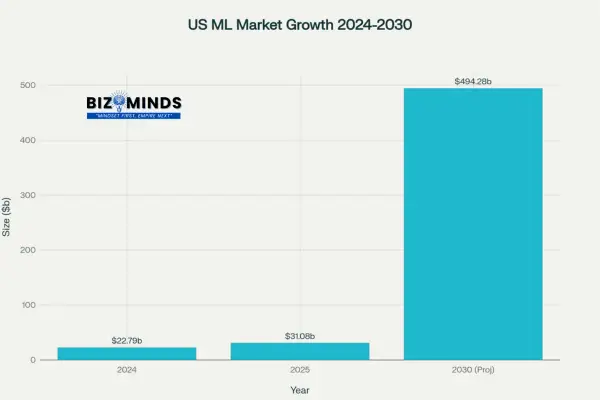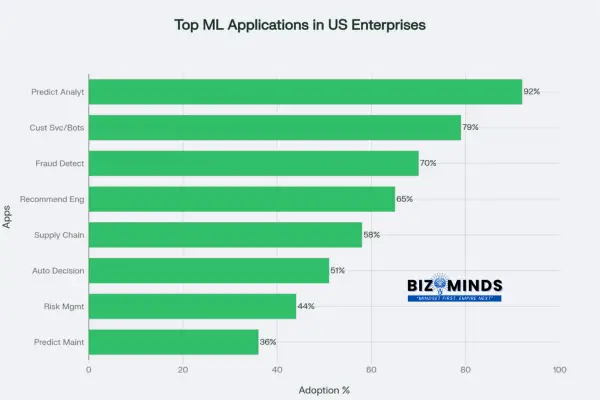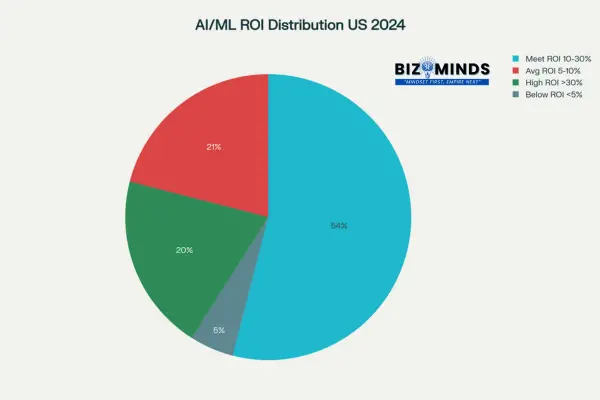

Machine Learning Applications Every Business Leader Must Know About
At 6:47 AM in a Cleveland emergency room, a construction worker’s life hangs in the balance as machine learning applications instantly analyze his chest pain symptoms, medical history, and vital signs to predict cardiac risk. Simultaneously, across the country in Seattle, intelligent algorithms are calculating exactly how many caramel macchiatos a Starbucks location will need today, while in New York, JPMorgan Chase’s systems silently process thousands of transactions to prevent fraud before Wall Street awakens. This isn’t a glimpse into the future—this is the reality of American business today, where machine learning applications have seamlessly integrated into our daily operations, influencing everything from critical healthcare decisions to our morning coffee routine.
The financial landscape surrounding this transformation demands attention from every business leader. The US machine learning market has exploded from $22.79 billion in 2024 to a projected $494.28 billion by 2030, representing a remarkable 36.02% compound annual growth rate. These figures transcend mere statistics, representing a fundamental restructuring of how American enterprises create value, deliver customer experiences, and sustain competitive advantages. When industry giants like Walmart harness machine learning applications to process 2.5 petabytes of data hourly, or JPMorgan Chase achieves trading win rates jumping from 52% to over 60%, we’re witnessing the birth of a new business paradigm.
The universality of adoption marks a critical turning point in corporate America. Every Fortune 500 company now employs machine learning applications in some form, signaling the transition from early adopter advantage to competitive necessity. This widespread implementation represents more than technological progress—it embodies the emergence of an intelligence-driven economy where data-powered decision-making has evolved from advantageous to absolutely essential for organizational survival. The gap between transformative potential and practical understanding has created both extraordinary opportunities and significant risks for businesses that fail to adapt.
Behind every algorithmic improvement lies profound human impact that business leaders must recognize. Each advancement in fraud detection protects real families from financial ruin, while predictive maintenance innovations preserve jobs and strengthen manufacturing communities across America. When machine learning applications enable small retailers to compete with Amazon’s sophisticated recommendation systems, the implications extend beyond technology to encompass the preservation of entrepreneurial opportunity and the American dream of business innovation.
For business leaders navigating this transformation, understanding machine learning applications has become crucial for organizational relevance in an increasingly intelligent economy. The question facing executives isn’t whether machine learning applications will revolutionize their industry—that revolution is already in motion. Instead, leaders must decide whether to spearhead this transformation or risk obsolescence in a marketplace increasingly dominated by adaptive, learning systems. Companies mastering machine learning applications today will shape tomorrow’s competitive environment, while those hesitating may find themselves relegated to historical footnotes in American business innovation.

US Machine Learning Market Size Growth showing dramatic expansion from $22.79B in 2024 to projected $494.28B in 2030
The Current State of Machine Learning Applications in American Business
The landscape of machine learning applications has shifted dramatically, and American businesses are at the epicenter of this transformation. Recent data reveals that 65% of US hospitals now use predictive models integrated with their electronic health records, while 88% of mid-to-large organizations allocate more than 5% of their IT budget specifically to machine learning applications. This isn’t just technology adoption—it’s a fundamental reimagining of business operations.
The most striking revelation comes from comprehensive research showing that all Fortune 500 companies now use these applications in some capacity. This universal adoption represents a seismic shift from just five years ago when these applications were considered experimental or niche technologies. Today’s business leaders understand that these applications aren’t optional enhancements—they’re essential components of modern competitive strategy.
Market Dynamics and Investment Trends
The financial commitment to these applications reflects their strategic importance. Enterprise AI spending is projected to rise 5.7% in 2025, with these applications accounting for $3.4 million of the average $11.5 million increase in IT budgets. This investment pattern reveals something profound about how business leaders view machine learning applications: not as costs to be minimized, but as assets to be maximized.
What makes these investments particularly noteworthy is their focus on measurable returns. Companies implementing these applications report average ROI figures that vary significantly based on implementation quality and strategic alignment. While the average enterprise AI project achieves 5.9% ROI, organizations with mature machine learning applications and robust data management systems report returns exceeding 30%.

Top Machine Learning Applications in USA Enterprises showing adoption rates across different business functions
The distribution of these applications across business functions reveals strategic priorities that resonate with operational leaders. Predictive analytics leads adoption at 92%, followed by customer service chatbots at 79%, and fraud detection at 70%. These percentages aren’t just statistics—they represent millions of hours saved, countless customer interactions improved, and billions of dollars protected from fraudulent activities.
Revolutionary Machine Learning Applications Transforming Industries
Healthcare: Saving Lives Through Intelligent Systems
In America’s healthcare system, machine learning applications are literally matters of life and death. The transformation is both profound and personal, touching every aspect of patient care from diagnosis to treatment planning. Consider the work being done at PathAI, where these applications analyze tissue samples to detect cancer with unprecedented accuracy. Their AIM-HER2 Breast Cancer system provides automated, reproducible digital scoring with explainable AI heatmap visualizations, transforming how oncologists approach breast cancer diagnosis.
The scope of these applications in healthcare extends far beyond individual diagnoses. At Johns Hopkins Hospital, a 24-person command center uses these applications to analyze patient flow, predict bed availability, and optimize resource allocation. Since implementation, the hospital reports a 60% improvement in admitting patients with complex medical conditions and 30% faster bed assignments in emergency departments. These aren’t just efficiency metrics—they represent thousands of patients receiving faster, more accurate care when they need it most.
Key Machine Learning Applications in US Healthcare:
- Diagnostic Support Systems: Analyzing medical imaging data to identify abnormalities with greater accuracy than traditional methods
- Predictive Analytics: Forecasting patient health trajectories and identifying high-risk individuals before critical events occur
- Drug Discovery: Accelerating pharmaceutical research through pattern recognition in molecular structures
- Healthcare administrative automation enables faster billing management while reducing repetitive tasks, ensuring providers spend less time on paperwork and more time on patient care
- Personalized Treatment Planning: Tailoring therapeutic approaches based on individual patient data and treatment response patterns
The emotional impact of these applications cannot be overstated. When a radiologist at Massachusetts General Hospital uses AI-powered diagnostic tools to detect early-stage cancer that might otherwise be missed, it’s not just about technological advancement—it’s about families staying together, children keeping their parents, and communities maintaining their strength through health and wellness.
Financial Services: Securing Trust in the Digital Economy
The financial sector’s embrace of machine learning applications represents one of the most comprehensive transformations in business history. JPMorgan Chase’s deployment of these applications across fraud detection, risk management, and trading operations demonstrates the technology’s versatility and impact. Their neural networks analyze over 100 million data points for fraud detection alone, while their risk management systems process vast datasets to make split-second decisions about creditworthiness and market exposure.
The role of the human element is vital to fully grasp how these applications function and deliver value. When Bank of America’s virtual assistant Erica helps customers manage their finances, it’s not replacing human financial advisors—it’s augmenting their capabilities and making financial guidance accessible 24/7. This democratization of financial expertise through these applications means that working families can access sophisticated financial planning tools that were once available only to high-net-worth individuals.
Transformative Machine Learning Applications in Financial Services:
- Real-time Fraud Detection: Analyzing transaction patterns to identify suspicious activities within milliseconds
- Algorithmic Trading: Optimizing trade execution and market timing through pattern recognition and predictive modeling
- Risk Assessment: Evaluating credit risks and market exposures using comprehensive data analysis
- Customer Service Automation: Providing instant responses to customer inquiries through intelligent chatbots
- Regulatory Compliance: Monitoring transactions and communications to ensure adherence to financial regulations
- Personalized Financial Planning: Offering customized investment advice and financial recommendations based on individual circumstances
The speed and accuracy of modern machine learning applications in finance are reshaping customer expectations and competitive dynamics. When JPMorgan Chase reduced their order routing latency from 50 milliseconds to under 5 milliseconds using these applications, they didn’t just improve technical performance—they gained competitive advantages worth hundreds of millions of dollars in improved market responsiveness.
Retail Revolution: Personalizing the American Shopping Experience
The retail sector’s adoption of these applications has fundamentally altered how Americans shop, discover products, and interact with brands. Amazon’s recommendation engine, powered by sophisticated such applications, drives billions in additional revenue by suggesting products customers didn’t even know they wanted. This isn’t just about selling more products—it’s about creating shopping experiences that feel personally curated and genuinely helpful.
Walmart’s approach to these applications demonstrates how traditional retailers can compete in the digital age. Their Data Café in Bentonville, Arkansas, processes 2.5 petabytes of data hourly through such applications that optimize inventory, predict demand, and enhance customer experiences. When these systems prevent food spoilage by analyzing refrigeration data and sales velocity, they’re not just reducing waste—they’re ensuring that families find fresh, quality products on store shelves.
Revolutionary Machine Learning Applications in Retail:
- Demand Forecasting: Predicting product demand with 85% accuracy up to 8 weeks in advance
- Inventory Optimization: Reducing excess inventory by 10% while improving shelf availability by 15%
- Personalized Recommendations: Increasing conversion rates by 20-30% through intelligent product suggestions
- Dynamic Pricing: Adjusting prices in real-time based on demand, competition, and inventory levels
- Supply Chain Management: Optimizing logistics and distribution networks for efficiency and cost reduction
- Customer Behavior Analysis: Understanding shopping patterns to improve store layouts and product placement
The emotional connection between retailers and customers is strengthened through these applications that remember preferences, anticipate needs, and provide seamless experiences. When Target’s such applications help expecting parents discover baby products at just the right time, it’s not just data science—it’s technology serving human needs at life’s most important moments.
Manufacturing Excellence: Optimizing American Production
American manufacturers are leveraging these applications to maintain competitive advantages in global markets while creating safer, more efficient work environments. Ford Motor Company’s implementation of these applications for predictive maintenance has reduced equipment downtime by 25% while decreasing defects per unit. These improvements translate directly into job security for manufacturing workers and higher quality products for consumers.
The impact of these applications in manufacturing extends beyond efficiency metrics to touch the lives of workers and communities. When Continental’s these applications predict equipment failures before they occur, they’re not just preventing costly downtime—they’re ensuring worker safety and maintaining the economic vitality of manufacturing communities across America.
Essential Machine Learning Applications in Manufacturing:
- Predictive Maintenance: Forecasting equipment failures to prevent unplanned downtime and ensure worker safety
- Quality Control: Using computer vision to detect product defects with greater accuracy than human inspection
- Supply Chain Optimization: Coordinating complex logistics networks to minimize costs and delivery times
- Production Planning: Optimizing manufacturing schedules based on demand forecasts and resource availability
- Energy Management: Reducing power consumption and environmental impact through intelligent system control
- Worker Safety: Monitoring workplace conditions and predicting potential safety hazards
Implementation Strategies and Best Practices
Building a Foundation for Success
The journey toward successful machine learning applications implementation begins long before algorithms are deployed or models are trained. Organizations that achieve the highest ROI from these applications share common characteristics: they start with clear business objectives, invest in data quality, and maintain realistic expectations about timelines and outcomes.
The most successful machine learning applications implementations follow a structured approach that prioritizes business value over technical sophistication. Companies like Walmart and JPMorgan Chase didn’t achieve their machine intelligence applications success overnight—they invested years in building data infrastructure, training teams, and refining processes that support intelligent systems.
Critical Success Factors for these applications:
- Executive Leadership: Securing C-suite commitment and establishing clear accountability for these applications outcomes
- Data Infrastructure: Building robust systems for collecting, storing, and processing the data that powers these applications
- Talent Development: Training existing employees and hiring specialists who understand both technology and business requirements
- Change Management: Preparing organizational culture for the operational changes that these applications require
- Performance Measurement: Establishing metrics that accurately reflect the business impact of such applications
- Ethical Governance: Implementing frameworks that ensure these applications operate fairly and transparently
Overcoming Implementation Challenges
The path to successful machine learning applications deployment is rarely smooth, and understanding common pitfalls helps organizations avoid costly mistakes. Data quality issues top the list of implementation challenges, with many companies discovering that their existing data infrastructure cannot support sophisticated machine studying applications. This reality forces organizations to invest in data cleaning, integration, and governance processes that may take months or years to complete.
The human element of these applications implementation often proves more challenging than technical considerations. Resistance to change, skill gaps, and organizational inertia can undermine even the most technically sound machine learning applications. Successful implementations address these challenges through comprehensive training programs, clear communication about benefits and changes, and involvement of employees in the design and deployment process.
Common Implementation Obstacles and Solutions:
- Data Quality Issues: Implementing comprehensive data governance and quality management processes
- Skills Shortages: Developing internal capabilities through training and strategic hiring
- Integration Complexity: Planning carefully for compatibility with existing systems and workflows
- Budget Overruns: Establishing realistic cost estimates and maintaining contingency funds
- Performance Expectations: Setting measurable goals and tracking progress transparently
- Cultural Resistance: Engaging stakeholders early and demonstrating clear benefits

AI/ML Investment ROI Distribution showing how US enterprises are performing with their AI investments in 2024
The ROI distribution of such applications investments reveals important patterns about implementation success. While 20% of organizations achieve exceptional returns exceeding 30%, and 54% meet their ROI expectations with returns between 10-30%, the remaining organizations struggle to demonstrate clear value from their machine learning applications investments. This distribution underscores the importance of strategic planning, proper implementation, and realistic expectations.
Measuring Success and ROI
Quantifying the Impact of Machine Learning Applications
The measurement of these applications success requires sophisticated approaches that capture both quantitative and qualitative benefits. Organizations achieving the highest returns from these applications employ comprehensive measurement frameworks that track efficiency gains, cost reductions, revenue increases, and customer satisfaction improvements.
The challenge of measuring these applications ROI lies in capturing benefits that may be indirect or intangible. When these applications enable faster decision-making, improve customer experiences, or reduce risks, the financial impact may not be immediately apparent but can be substantial over time. Leading organizations address this challenge by establishing baseline measurements before implementation and tracking multiple indicators of success throughout the deployment process.
Key Performance Indicators for these applications:
- Operational Efficiency: Measuring time savings, error reductions, and process improvements
- Financial Performance: Tracking revenue increases, cost savings, and profit improvements
- Customer Impact: Monitoring satisfaction scores, retention rates, and engagement metrics
- Risk Mitigation: Assessing fraud detection rates, compliance improvements, and security enhancements
- Innovation Metrics: Evaluating new product development speed and market responsiveness
- Employee Productivity: Measuring task automation and capability enhancement
Long-term Value Creation
The most successful machine learning applications create compounding value over time as systems learn, adapt, and improve. This dynamic aspect of these applications ROI means that organizations must think beyond immediate returns to consider long-term competitive advantages and market positioning.
Companies like Amazon and Google have demonstrated how these applications can create sustainable competitive moats through network effects and continuous improvement cycles. Their machine learning applications become more valuable as they process more data, serve more customers, and refine their algorithms, creating barriers to entry that protect market positions for years or decades.
Future Trends and Opportunities
Emerging Technologies and Applications
The future landscape of these applications promises even more transformative possibilities as technologies like autonomous AI agents, multimodal AI systems, and quantum computing mature. These advances will enable machine learning applications that can handle more complex tasks, make more sophisticated decisions, and operate with greater independence than current systems.
The convergence of machine learning applications with other emerging technologies—including Internet of Things (IoT), 5G networks, and edge computing—will create new possibilities for real-time intelligence and distributed decision-making. These combinations will enable machine learning applications to operate in environments and scenarios that are currently impossible or impractical.
Emerging Frontiers in Machine Learning Applications:
- These autonomous AI systems can perform challenging operations independently, reducing the need for constant human intervention
- Multimodal AI: Machine learning applications that process text, images, audio, and video simultaneously
- Edge AI: Deploying machine learning applications directly on devices for real-time processing
- Quantum Machine Learning: Leveraging quantum computing for exponentially faster model training
- Federated Learning: Enabling machine learning applications across distributed data sources while preserving privacy
- Explainable AI: Making machine learning applications more transparent and interpretable
Strategic Implications for Business Leaders
Business leaders must prepare for a future where these applications become even more central to competitive advantage and operational excellence. This preparation requires strategic thinking about data assets, technological capabilities, and organizational readiness for continuous change and innovation.
The companies that will thrive in these applications-powered future are those that start building capabilities today. This includes investing in data infrastructure, developing analytical talent, and creating organizational cultures that embrace experimentation and learning.
Industry-Specific Applications and Case Studies
Technology Sector Leadership
The technology sector continues to lead innovation in these applications, with companies like Google, Microsoft, and Amazon driving advances that influence all other industries. Google’s Vertex AI platform provides Fortune 500 companies with comprehensive machine learning operations capabilities, while Microsoft’s Azure Machine Learning services enable organizations of all sizes to deploy sophisticated AI solutions.
These technology leaders don’t just create these applications for their own use—they democratize access to advanced capabilities through cloud platforms and services that make machine learning applications accessible to businesses regardless of size or technical expertise.
Healthcare Innovation
American healthcare organizations are pioneering these applications that improve patient outcomes while reducing costs. The Mayo Clinic’s investment in AI-powered diagnostic tools demonstrates how leading healthcare institutions are embracing these applications to enhance their clinical capabilities.
The integration of these applications with electronic health records represents a particularly promising development, with 79% of hospitals using models from their EHR developers and 54% developing their own predictive models. This trend suggests that these applications will become as fundamental to healthcare as stethoscopes and X-ray machines.
Financial Services Evolution
The financial services sector’s adoption of these applications continues to accelerate, driven by regulatory requirements, competitive pressures, and customer expectations. Beyond traditional applications in fraud detection and risk management, financial institutions are exploring these applications for regulatory reporting, customer service, and investment advisory services.
The success of companies like JPMorgan Chase in implementing machine learning applications across multiple business functions provides a roadmap for other financial institutions seeking to modernize their operations and improve their competitive positions.
Practical Recommendations for Business Leaders
Getting Started with Machine Learning Applications
Business leaders approaching machine learning applications for the first time should focus on identifying specific business problems that technology can solve rather than starting with technological capabilities and looking for applications. The most successful machine learning applications implementations begin with clear business objectives and work backward to identify appropriate technological solutions.
Essential Steps for These applications Implementation:
- Define Business Objectives: Clearly articulate what problems these applications should solve
- Assess Data Readiness: Evaluate the quality and availability of data needed for these applications
- Start with Pilot Projects: Begin with small-scale implementations that can demonstrate value quickly
- Build Internal Capabilities: Invest in training and hiring to develop these applications expertise
- Establish Governance: Create frameworks for managing data, algorithms, and ethical considerations
- Plan for Scale: Design systems and processes that can expand as machine learning applications prove successful
Building Organizational Readiness
The organizational aspects of these applications implementation often prove more challenging than technical considerations. Companies must prepare their culture, processes, and people for the changes that machine learning applications bring to daily operations and decision-making processes.
Successful machine learning applications implementations require collaboration between technical teams and business users, with clear communication about capabilities, limitations, and expectations. This collaboration ensures that machine learning applications serve real business needs rather than becoming technical exercises that don’t deliver practical value.
Ethical Considerations and Governance
Responsible AI Implementation
As machine learning applications become more prevalent and powerful, ethical considerations become increasingly important for business leaders. Organizations must ensure that their machine learning applications operate fairly, transparently, and in accordance with societal values and legal requirements.
The development of AI ethics frameworks and governance structures represents a critical investment in long-term success and risk management. Companies that proactively address ethical considerations in their machine learning applications are more likely to maintain customer trust, avoid regulatory penalties, and achieve sustainable competitive advantages.
Key Ethical Principles for Machine Learning Applications:
- Fairness in machine learning focuses on creating unbiased systems that do not disadvantage protected groups or replicate past inequalities
- Transparency: Making these applications decisions explainable and auditable
- Privacy: Protecting individual data and respecting customer privacy preferences
- Accountability: Maintaining human oversight and responsibility for machine learning applications outcomes
- Security: Protecting machine learning applications systems from manipulation and attack
- Beneficence: Ensuring that machine learning applications create positive outcomes for society
Governance Frameworks
Effective governance of machine learning applications requires cross-functional collaboration between legal, technical, and business teams. This collaboration ensures that machine learning applications comply with regulations, operate ethically, and deliver intended business value.
The most effective governance frameworks for machine learning applications include regular audits, bias testing, performance monitoring, and stakeholder feedback mechanisms. These frameworks help organizations identify and address issues before they become serious problems or public relations challenges.
Conclusion
As we stand at the threshold of an unprecedented transformation in American business, the evidence overwhelmingly demonstrates that machine learning applications have evolved from experimental technologies into fundamental pillars of competitive advantage. The journey from a $22.79 billion market in 2024 to a projected $494.28 billion by 2030 represents more than exponential growth—it signifies the emergence of a new economic paradigm where intelligent systems are no longer optional enhancements but essential infrastructure.
The universal adoption across Fortune 500 companies and the commitment to increase AI spending by 14% year-over-year in 2025 confirms that the window for treating machine learning applications as future considerations has definitively closed. Organizations that master these technologies today will shape the competitive landscape of tomorrow, while those hesitating risk becoming footnotes in the annals of business history.
The strategic imperative for business leaders extends far beyond mere technology adoption to encompass a fundamental reimagining of operational excellence and value creation. The most successful machine learning applications implementations demonstrate that victory belongs to organizations that align these technologies with clear business objectives rather than pursuing technological sophistication for its own sake.
AI adoption is accelerating, with 86% of firms expecting major transformation by 2030 and over half of disruptors driving profits through AI. The takeaway: machine learning will define business competition in the decade ahead. The companies achieving 30%+ ROI from their machine learning applications investments share common characteristics—executive leadership commitment, robust data infrastructure, comprehensive change management, and realistic expectations about implementation timelines and outcomes.
The human dimension of this transformation cannot be overlooked, as machine learning applications ultimately serve to amplify human capability rather than replace human judgment. From the Cleveland emergency room where algorithms help save lives to the Seattle coffee shop where predictive analytics ensure customer satisfaction, these technologies succeed when they enhance human decision-making and improve real outcomes for real people.
The future belongs to organizations that embrace machine learning applications not as abstract technological concepts but as powerful tools for solving genuine business problems, serving customers better, and creating meaningful value for all stakeholders. The question facing every business leader today isn’t whether machine learning applications will reshape their industry—that transformation is already underway. The only remaining question is whether they will lead this revolution or be swept away by it. The choice, and the opportunity, remains yours to make.
Frequently Asked Questions
1. What are machine learning applications and how do they differ from traditional software?
Machine learning applications are software systems that can learn and improve their performance from data without being explicitly programmed for every scenario. Unlike traditional software that follows predetermined rules and logic, these applications analyze patterns in data to make predictions, classifications, and decisions. For example, a traditional software system might follow specific rules to approve or deny a loan application, while these applications would analyze thousands of loan applications and their outcomes to develop sophisticated models that can evaluate new applications with greater accuracy and nuance.
2. How much should a business expect to invest in machine learning applications implementation?
Investment in machine learning applications varies significantly based on project scope, data complexity, and organizational readiness. According to recent research, companies typically allocate 5-25% of their IT budgets to AI and machine learning applications, with average increases of $3.4 million in 2025. However, successful implementations require considering total cost of ownership, including data infrastructure, talent acquisition, training, and ongoing maintenance. Small businesses might start with pilot projects costing $50,000-$200,000, while enterprise implementations can require millions in initial investment.
3. What ROI can businesses realistically expect from machine learning applications?
ROI from machine learning applications varies widely based on implementation quality and business objectives. While average enterprise AI projects achieve 5.9% ROI, well-executed machine learning applications can deliver returns exceeding 30%. Companies implementing these applications report benefits including 25-40% improvements in process efficiency, 15-30% cost reductions, and 30-50% enhancement in decision accuracy. The key is setting realistic expectations, measuring comprehensive benefits including intangible gains, and focusing on applications that address specific business problems.
4. Which machine learning applications should businesses prioritize first?
Businesses should prioritize these applications based on their specific challenges and available data. However, predictive analytics (92% adoption), customer service chatbots (79% adoption), and fraud detection (70% adoption) represent the most common starting points. These applications often provide clear, measurable benefits and don’t require extensive infrastructure changes. Companies should begin with applications that have well-defined success metrics, sufficient data availability, and strong business sponsor support.
5. How long does it typically take to implement machine learning applications successfully?
Machine learning applications implementation timelines range from 6 months for simple pilot projects to 12-18 months for comprehensive enterprise deployments. Successful AI and business implementations rely on continuous improvement, regular refinement, and structured optimization. Companies often underestimate the time needed for data preparation, which can account for 60-80% of project timelines. Organizations with existing data infrastructure and analytical capabilities can move faster, while those needing foundational investments should plan for longer implementation cycles.
6. What are the biggest challenges in implementing machine learning applications?
The most significant challenges include data quality and availability (affecting 70% of projects), skills shortages in data science and machine learning (60% of companies), integration with existing systems (55%), and organizational resistance to change (45%). Technical challenges often prove easier to address than cultural and organizational obstacles. Successful implementations require comprehensive change management, executive leadership support, and realistic expectations about timelines and outcomes.
7. How do machine learning applications impact employment and job roles?
These applications typically augment rather than replace human workers, though they do change job requirements and responsibilities. Research shows that these applications boost productivity by 20-30% for junior employees and 10-15% for senior staff. As routine tasks shift to automation, the workforce evolves toward roles in analytics, system monitoring, and enhanced collaboration with AI. Companies implementing these applications successfully invest heavily in employee training and skill development to prepare their workforce for changing job requirements.
8. What data requirements are necessary for successful machine learning applications?
These applications require high-quality, relevant, and sufficient data to function effectively. Generally, supervised learning models need hundreds to thousands of examples for simple tasks, while complex applications may require millions of data points. Data quality is more important than quantity—clean, accurate, well-labeled data produces better results than large volumes of poor-quality information. Companies should audit their data assets, implement data governance processes, and plan for ongoing data collection and management as part of these applications strategy.
9. How can businesses measure the success of their machine learning applications?
Success measurement requires establishing baseline metrics before implementation and tracking multiple performance indicators. Key metrics include operational efficiency improvements, cost savings, revenue increases, customer satisfaction enhancements, and risk reduction. Companies should measure both quantitative benefits (processing time, error rates, conversion rates) and qualitative outcomes (employee satisfaction, customer experience, decision quality). Regular monitoring and evaluation help identify areas for improvement and demonstrate business value to stakeholders.
10. What ethical considerations should businesses address when implementing machine learning applications?
Ethical considerations include ensuring fairness and preventing bias, maintaining transparency in decision-making processes, protecting customer privacy and data, establishing human accountability for AI decisions, and considering societal impact. Businesses should implement governance frameworks that include diverse stakeholders, regular audits for bias and fairness, clear policies on data use and privacy, and mechanisms for addressing concerns or complaints. Proactive attention to ethics helps maintain customer trust and avoid regulatory problems.
11. How do machine learning applications integrate with existing business systems?
Integration challenges often prove more complex than anticipated, particularly with legacy systems not designed for these applications. Seamless integration relies on careful planning, robust APIs, middleware technologies, and in some cases, extensive system modifications. Companies should conduct thorough technical assessments, plan for potential disruptions, and consider cloud-based solutions that offer better integration capabilities. Phased implementation approaches help identify and address integration issues before they become critical problems.
12. What future trends should business leaders monitor in machine learning applications?
Key trends include the rise of autonomous AI agents capable of complex task completion, multimodal AI systems processing multiple data types simultaneously, edge AI deployment for real-time processing, and explainable AI making systems more transparent. Business leaders should also monitor developments in quantum machine learning, federated learning for privacy-preserving AI, and industry-specific applications tailored to particular business sectors. Staying informed about these trends helps organizations plan strategic investments and maintain competitive advantages.








